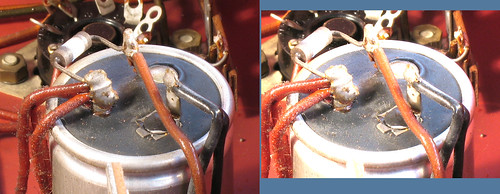I've retrieved my old Armstrong PCU25/A20 pre/power amplifier pair from the attic, where they've been since 1996 (and the purchase of the big Sugden).
They were my only amplifier between 1984 and 1996 (they were bought for fun from a antique(junk) shop, but turned out to be nicer than my Rotel 840BX).
I left them in the lounge to acclimatise for a couple of days, then powered them up, driven by a CD player, and driving my Spendor Preludes. It turned out, the passage of time has not been kind. All kinds of buzzes and crackles. I did "the obvious" and hit all the valve sockets, umbilical socket and input selector contacts with "Kontakt 2000 Gold" contact cleaner. 5 minutes were spent twiddling the control pots, cycling the front panel switches, and playing with the input selector.
Ah - much better - it pretty much works, although changing to a vintage 12W valve amp and Spendor Preludes dumped on the floor from a 100W Sugden into Epos 22's is a substantial downgrade. I tried the CD player into the high level inputs (Tape1/Radio/Aux) and my Roksan Xerxes into the "Gram" input. Amplification is definitely happening.
Sadly, after an hours running, something bad developed. Whilst the amplifier has some low level hiss and mains hum, the left channel (channel 'A') started making a noise I can best describe as sounding like a dirty contact being continously made and broken; a sort of scratchy sound, that also varies a little over time. Meanwhile (not to be outdone) the right ('B') channels makes the occasional 'pop'. Interestingly, I noted than when I powered the amp down, it generated the same kind of pops from both channels.
Checking visually, I spotted that both large electrolytic caps have a bulge in their black bases, and a resistor across the main reservoir cap is (I think) burnt out. It's literally white in the middle. (I've presented the photo with two brightness levels to try and show the bulge in the black material, which isn't easy)
 cap_resis by plybench, on Flickr
cap_resis by plybench, on Flickr
So - is any of what I've described indicative of a "classic, well known fault" that valve amps are prone to, that is a quick and easy fix? Or does it need (and deserve) a full refurb/restore?
They were my only amplifier between 1984 and 1996 (they were bought for fun from a antique(junk) shop, but turned out to be nicer than my Rotel 840BX).
I left them in the lounge to acclimatise for a couple of days, then powered them up, driven by a CD player, and driving my Spendor Preludes. It turned out, the passage of time has not been kind. All kinds of buzzes and crackles. I did "the obvious" and hit all the valve sockets, umbilical socket and input selector contacts with "Kontakt 2000 Gold" contact cleaner. 5 minutes were spent twiddling the control pots, cycling the front panel switches, and playing with the input selector.
Ah - much better - it pretty much works, although changing to a vintage 12W valve amp and Spendor Preludes dumped on the floor from a 100W Sugden into Epos 22's is a substantial downgrade. I tried the CD player into the high level inputs (Tape1/Radio/Aux) and my Roksan Xerxes into the "Gram" input. Amplification is definitely happening.
Sadly, after an hours running, something bad developed. Whilst the amplifier has some low level hiss and mains hum, the left channel (channel 'A') started making a noise I can best describe as sounding like a dirty contact being continously made and broken; a sort of scratchy sound, that also varies a little over time. Meanwhile (not to be outdone) the right ('B') channels makes the occasional 'pop'. Interestingly, I noted than when I powered the amp down, it generated the same kind of pops from both channels.
Checking visually, I spotted that both large electrolytic caps have a bulge in their black bases, and a resistor across the main reservoir cap is (I think) burnt out. It's literally white in the middle. (I've presented the photo with two brightness levels to try and show the bulge in the black material, which isn't easy)
 cap_resis by plybench, on Flickr
cap_resis by plybench, on FlickrSo - is any of what I've described indicative of a "classic, well known fault" that valve amps are prone to, that is a quick and easy fix? Or does it need (and deserve) a full refurb/restore?

